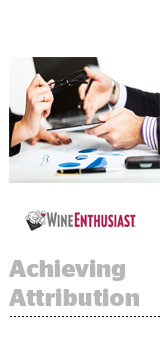 Despite Wine Enthusiast’s history marketing through direct mail, the purveyor of accessories and storage for wine connoisseurs is pushing into digital channels to complement its catalog business.
Despite Wine Enthusiast’s history marketing through direct mail, the purveyor of accessories and storage for wine connoisseurs is pushing into digital channels to complement its catalog business.
Founded in 1979, Wine Enthusiast has published more than 300 million catalogs to date. It has a publishing arm, several Internet properties and a B2B distribution division responsible for placing branded products on store shelves. Like most direct mail businesses looking to tap the potential of digital sales, there have been several unforeseen problems along the way.
“I could talk about Amazon for hours because they’re such a behemoth and, to us, they’re a competitor but they’re also a partner in a sense because we have branded products sold on Amazon,” said Glenn Edelman, VP of digital marketing for Wine Enthusiast. “How do I convince someone, when I’m selling my Wine Enthusiast wine fridge on my site, but it’s also on Amazon, to buy it from me?”
Wine Enthusiast employs eight wine storage consultants in a quasi-call center at its upstate New York headquarters (representatives even field calls from Amazon customers) and makes a concerted effort to entice customers to pick up their phones. This is unusual compared to most enterprises that try to drive communications through cheaper digital channels.
But Wine Enthusiast’s call center is less about customer service and more about marketing. It’s a high-touch channel where customers, whose average order is $500, can get advice and individual attention on big ticket items. This, said Edelman, is a major point of differentiation from Amazon’s DIY style of purchasing. So unlike many marketers, whose cross-channel strategies connect mobile, social and online activity, Wine Enthusiast needs to link its digital messaging with one of the most traditional channels of all: the telephone.
By utilizing cross-channel marketing attribution tool Convertro, Edelman said the company attached a pixel to all of its order confirmations that came through its call center; once the order confirmation is activated, it sends a signal back to Convertro, which then matches that phone order back to the customer’s Web activities.
“We found there was a 15% incrementality of online programs driving people to the phones,” Edelman said. “What used to look like a lost dollar spent, because [the contact center] is usually a high cost center for companies, I can now track back to closing someone over the phone who may have Googled ‘wine storage’ and can connect the dots there. That’s hugely important to me.”
Wine Enthusiast concurrently uses Convertro for paid media purposes such as display and paid search, but realized the most pronounced improvement when it cracked down on waste associated with coupon affiliate networks.
“[In 2011] we had many different affiliate vendors driving customers and orders to us and they would send me monthly reports and from the looks of it, they were all doing fantastic,” Edelman said. “Then I’d add up all their numbers, and the total commission [invoiced] was about 145% greater than what our actual revenue was for the month because they were all taking credit for everything. I was essentially giving a commission on 145% of the sale, rather than 100% of the sale.”
By deploying Convertro, and moving away from a “rudimentary” auditing system that consisted of a lot of Excel spreadsheets, Wine Enthusiast was able to identify sales potential in campaigns it once deemed unprofitable.
“We found people were coming to our site either through our catalog or PPC efforts, were going to the cart, and then saying ‘What [percent] additional can I get off?’ and then they’d go to the coupon site and see that they offered the same thing,” Edelman said. “They ended up clicking through on the affiliate link back to our site since that was easiest and coming back to our site and closing.” The affiliates were essentially collecting commission from organic conversions.
By reducing its reliance on network affiliates that did not drive new customers, during the last holiday season, Wine Enthusiast was able to cut costs paid to affiliates by 33% while simultaneously increasing total ROI by 49%.
Although catalogs remain Wine Enthusiast’s greatest allocation for advertising, a general awareness that digital planning is par for survival and that catalogs are expensive to mail (and that some consumers are pulling back on direct mail subscriptions in general) Wine Enthusiast plans more optimization of its marketing spend using Convertro.
“If I send somebody a catalog and they go to Google and they end up going somewhere else, I’d hate to have my marketing dollars spent on a competitor,” Edelman added. “We want to understand where our dollars in one channel are overlapping with other marketing programs and if I hit them with an email, do I really need to send them a catalog?”
Rooted in direct marketing where “if I spend a dollar, I have to show a return,” Edelman said the company will pursue brand advertising this year “since our product is now sold on Amazon, Costco, and Target. We’ve become a manufacturer. Not just a retailer.”














